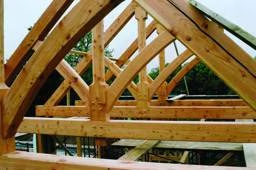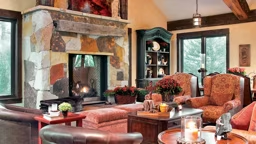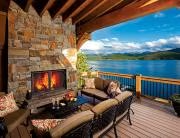
Throwing a good party is an art. It takes inspiration and organization. It also helps to have a space that’s designed with hosting in mind.
A home that’s ideal for entertaining doesn’t necessarily need to be large. Oversized spaces for the sake of size alone often feel uninviting. Scale matters more than size. The key is to design your home to be adaptable to parties of all sizes, whether it’s a casual potluck with a handful of friends or a large, formal cocktail party.
So how do you design a timber home your friends and family will flock to? We’ve pulled together our favorite tips to guide you along your way.
Look at your household makeup.
The stage of life you’re in likely will influence the type of soirees you hold, which, in turn will absolutely affect your entertaining needs and how your home will accommodate them. Are you empty nesters? Make sure your guest rooms are hospitable for when your kids come back for an overnight visit. Is yours a family with young children? You’re likely to have throngs of toddlers over for birthday parties for years — will your home be safe for them? Are your kids teens? They certainly need specialized entertainment (for ideas, see tip #9). And if you’re a couple without children, your get-togethers probably take on a very different, more sophisticated complexion. Evaluate the kind of entertaining you foresee holding now and in the not-so-distant future.
Consider your favorite ways to entertain.
Some people are backyard barbecue folks; some prefer wine-and-cheese affairs. Pizza and a movie in a professional-grade home theater, complete with tiered seating and blackout curtains, is how some entertainers roll; and, believe it or not, there are still people left on the planet who want to have a traditional sit-down dinner in a formal dining room. Give a lot of thought to how you like to entertain and design your home around these preferences. It’s a whole lot easier than trying to force a floor plan to fit your needs.
Design an inviting entry.
This is what your guests see first, and it sets the stage for their experience. If your timber home has a casual vibe, an entry that opens right into the living area works nicely, but if your home is grand, consider a formal foyer that makes a more dramatic entrance. Either way, ensure it has plenty of room for a group to comfortably take off their coats. A generously sized closet will keep you from having to lay coats across a chair or stash them in a spare bedroom, making them less awkward to retrieve when it’s time to leave.
Go with the flow.
Flow — the way spaces interact with each other while remaining distinct, as well as the ease with which people can move around in those rooms — is everything in a floor plan. Think about how guests will move around in the space, look for areas in your design where people can get “stuck,” then craft a solution on paper before you raise the first timber. Take your time to get the design right, and you’ll find it will result in a home that’s as versatile as the types of events you’ll host. 
Give the powder room some privacy.
A powder room is a must in any modern home, but give a good deal of thought as to where you place it in your floor plan. Many plans will put it near the kitchen for close proximity to plumbing, and this can save you money. However, most people prefer a little privacy when they use the loo and positioning the facilities so close to the action can create discomfort. Consider putting the powder room closer to the entry or in a hallway to instill some separation without sacrificing convenience.
Go behind the scenes.
One of the downsides of entertaining in an open floor plan is there’s nowhere to hide. When your kitchen is fully exposed to the living area, every one of your guests is part of the preparations, which can be a lot of fun; but they’re also part of the aftermath, meaning the mess is on display. Consider a dual-kitchen design, which features two distinct but connected kitchen spaces — one that is the “public space” — out in the open and designed for entertaining, and the other that’s more behind the scenes, where the clutter and dirty dishes can disappear out of sight. If you’re throwing a large party, this second kitchen is also where the catering staff can do their job unobstructed. If a traditional, single-kitchen design is more your speed, having sufficient storage is of paramount importance. A great way to accomplish this is to add a butler’s pantry into your plans. Much more than an oversized walk-in closet, this space provides a place to store all those entertaining essentials you don’t use day to day. It also can act as a staging area or even a coffee bar.
Use lighting to set a mood.
The best entertainers set a mood, and a vital element to establishing a desired feeling is through lighting. During the design phase, establish a layered lighting plan, meaning one that provides natural, ambient (general), task and accent lighting. Dimmer switches are inexpensive and go a long way to allowing you the flexibility to raise or lower a room’s illumination for everything from dimming the lights for a birthday cake blowout to going to full voltage during party-prep time.
Make it easy to maintain.
Whether you’re hosting a small group or a huge gathering, accidents are inevitable. It’s much easier to clean red wine off a hardwood floor than carpeting, but softer flooring will help prevent broken dishware when a guest drops a plate. There are other, less traumatic, maintenance items to consider, too. One example is changing a light bulb. Timber homes often have soaring ceilings, and when a bulb blows, it can be tough to access. If you have hanging lights, like pendants, ceiling fans or chandeliers, consider retractable fixtures or even installing motorized lifts that will put your lighting within reach.
Create a family-fun zone.
A lot of people have a space labeled “game room” in their floor plan, but when it’s built, it turns out to be more archaic than arcade. If your parties are multi-generational, make sure the kids (and the young at heart) have something to keep them entertained. A pool table is a great start, but only a few people can play at a time. Consider pinball, stand-up video games, and air hockey, not to mention a big screen, stereo and surround sound, so everyone can be engaged at once. The keys to success? Wide open spaces that aren’t constricted by support columns and a lot of electrical outlets, unless you want extension cords snaking around your floor.
Take it outside.
Blurring the lines between indoor and outdoor living is a common timber home design scheme. Retractable window walls will open up your great room to the great outdoors in a way no normal slider ever can. A three-season porch is another way to take the party outside when the weather is agreeable. But if you want to up the outdoor entertaining ante, features like a full outdoor kitchen, an amazing swimming pool or exotic tiki bar can’t be beat.
Add irresistible features.
Want to have friends clamoring for an invitation? Incorporate elements into your home that they won’t find at anyone else’s pad. Spaces as elaborate as a wine tasting room or a cigar bar will certainly make your timber home a standout, but so will simpler pursuits, like an outdoor clay pizza oven for “make your own pie night” or even a party dock, if you are lucky enough to live on the water. These types of unique areas are a surefire way to make your timber home the place to be.






_11868_2023-06-30_11-50-256x288.avif)



